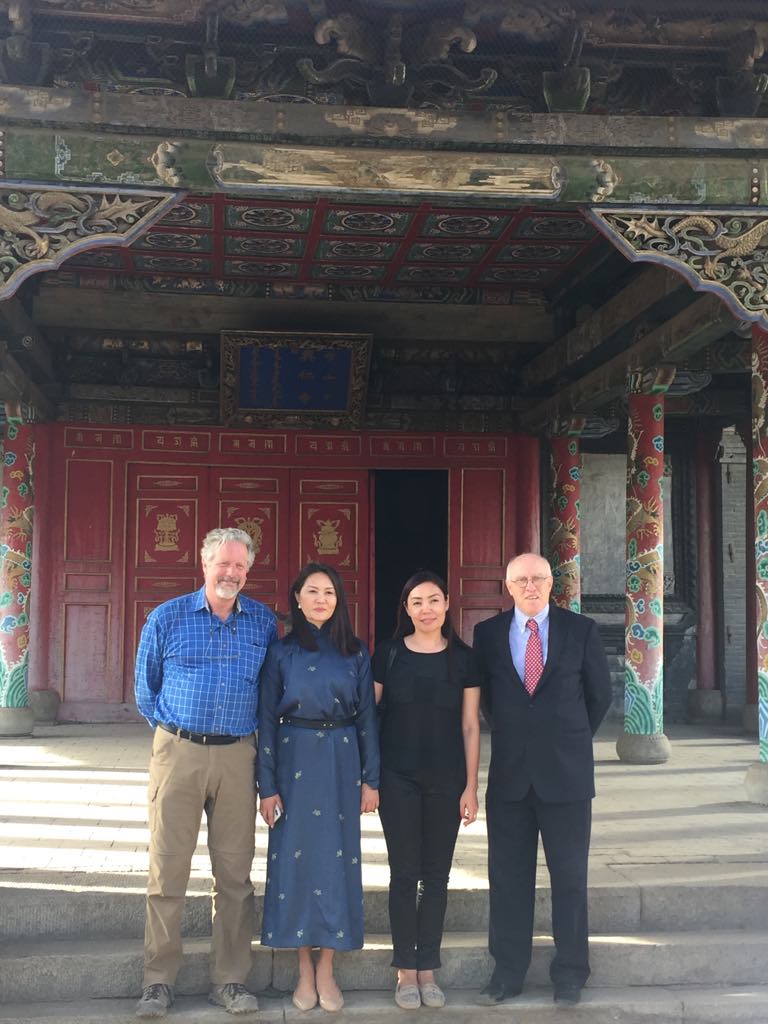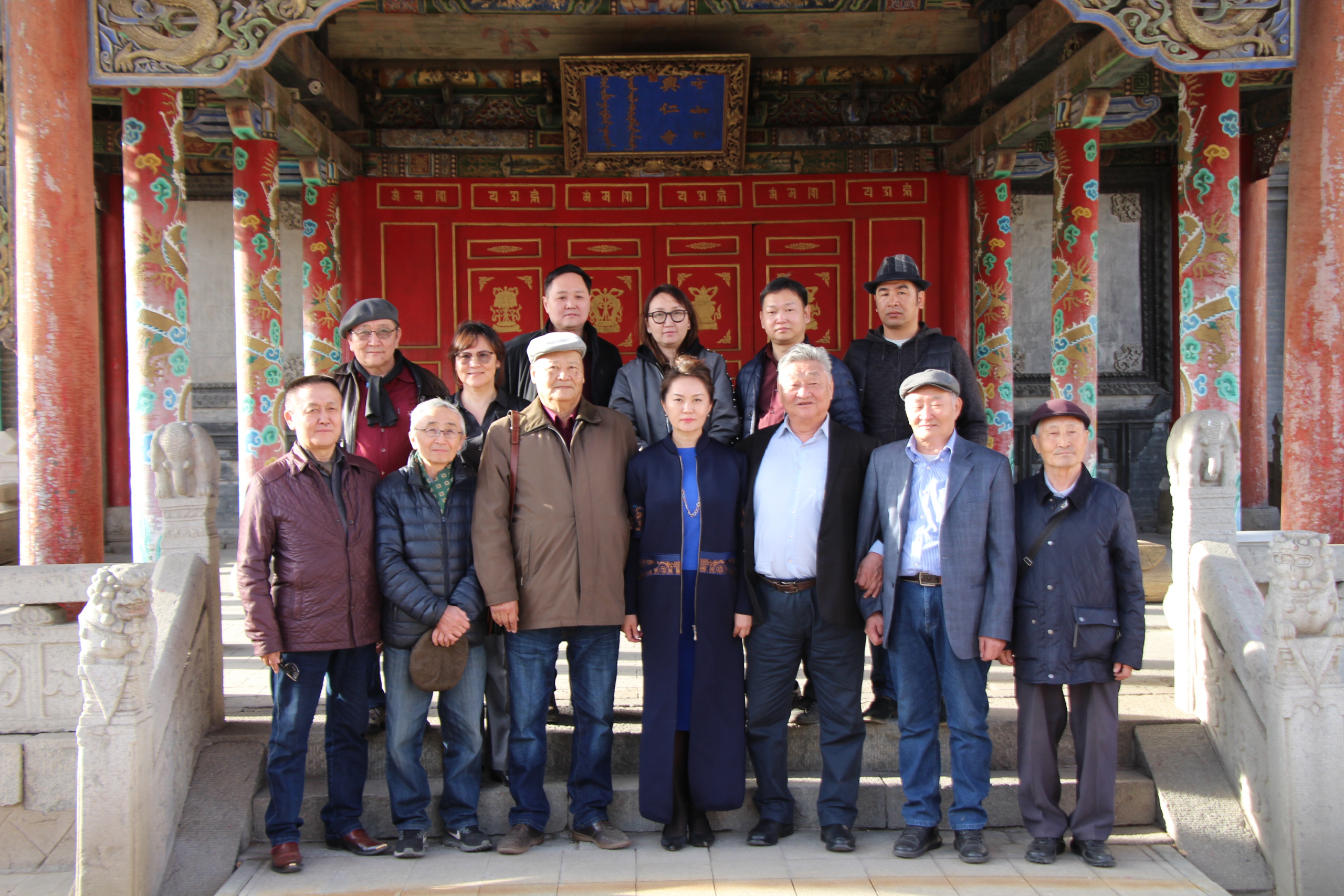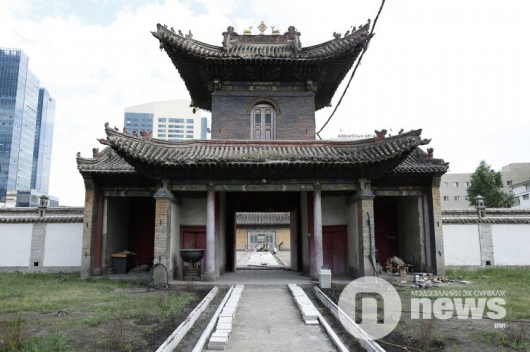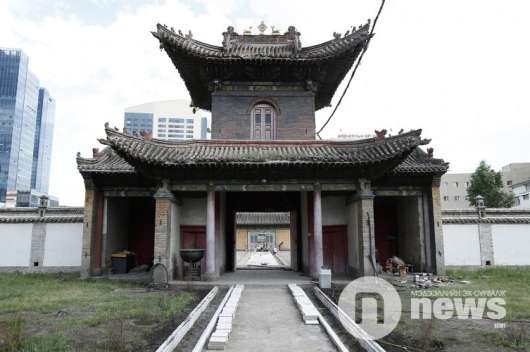Project aims to provide opportunities for local capacity-building in traditional crafts and conservation techniques
Ulaanbaatar, Mongolia, May 6, 2022—Arts Council of Mongolia (ACM) and World Monuments Fund (WMF) today announced the start of physical conservation on the Yadam Temple, situated within the enclosed Choijin Lama Temple complex in Ulaanbaatar, Mongolia, funded with support from the U.S. Ambassadors Fund for Cultural Preservation (AFCP).
Built in the beginning of the twentieth century, the temple of the Choijin Lama was one of the few remaining examples of iconic religious architecture in the center of Ulaanbaatar, Mongolia. Constructed out of blue brick and with timber roofs supported on wooden posts and decorated with green tiles, this complex contained five temples dedicated to different deities, including the Makhranz, or Maharajas—“great king” guardians of the four directions, the Shakyamuni Buddha, and the tantric deities worshipped by the Choijin Lama. Today, the Choijin Lama Temple Museum complex is a state-owned and nationally protected historic and cultural site.
The Yadam Temple was a private prayer hall for Choijin Lama to contemplate his secret mantra. The temple stands at the north end of the museum and houses a collection of copper and brass sculptures, scroll paintings, diverse artwork, and other instruments used for religious ceremonies. Eight of the objects displayed in the temple were included by the government in the list of exceptionally invaluable historical and cultural monuments of Mongolia.
Dismantling of the Yadam Temple roof will begin in early May by the restoration company Enerjin LLC, and the entire physical restoration continue through the end of 2022. In accordance with the law on the protection of cultural heritage, the Professional Council for Restoration, chaired by the Deputy Minister of Culture, will provide professional guidance.
The project aims to provide opportunities for local capacity-building in traditional crafts and conservation techniques. Once restored, the Yadam Temple will serve as a model for the benefits of incorporating traditional craftsmanship and following international standards and will set the stage for future restoration work at the Choijin Lama Temple Museum and in the country.
“The survival of heritage sites central to the cultural and spiritual life of communities is threatened by the loss of traditional construction methods,” said Bénédicte de Montlaur, WMF President and CEO. “We are thrilled to be working alongside Arts Council of Mongolia to restore the Yadam Temple while training the local residents to conserve their cultural heritage so it may be passed down to the next generation.”
Arts Council of Mongolia initiated its Cultural Heritage Program in 2006 with a goal to preserve, promote, disseminate Mongolian cultural heritage. Funded by US Ambassador’s Fund for Cultural Preservation grant, ACM carried out number of projects namely: the Danzanravjaa museum hall renovation, Documentation of Mongolian monasteries, the Amarbayasgalant Monastery Preventive Conservation project, and the Museum Preservation Training and Acid-Free Supply project.
Arts Council of Mongolia (ACM) is honored to partner with World Monuments Fund for conservation and protection of the Choijin Lama Temple Museum, one of the few remaining Buddhist temple complexes in Mongolia, by restoring the Yadam (Hallowed Divinity) Temple. In our role of stewards of the Choijin Lama Temple Museum, the ACM has been working with international and Mongolian experts to design a master plan for the conservation of the site. The restoration of the Yadam Temple will serve as a model that ACM hopes to work with WMF to present best practices and techniques in conservation, and Mongolian architectural arts and traditional building crafts.
“I think it is significant that since Mongolia embraced democracy, religious freedom has flourished, and I am proud that the United States is playing a constructive role in supporting and preserving Mongolian culture and sovereignty,” said Michael S. Klecheski, U.S. Ambassador to Mongolia.
In addition to the physical conservation work, this project will be monitored by WMF’s international technical control team, including conservation architect Stephen Kelley from the United States, timber architecture expert Xiao Jinliang from Tsinghua Urban Planning and Design Institute, and mural specialist Guo Hong from University of Science and Technology Beijing, as well as the local taskforce led by the Arts Council of Mongolia, including architect Z. Oyunbileg, construction engineer Bayasgalan and exterior painting expert Adiya.
World Monuments Fund’s work at the Choijin Lama Temple began in 2020, following the site’s inclusion on the World Monuments Watch. At that time, the Arts Council of Mongolia was seeking visibility and support to design a master plan for the conservation of the site.
Arts Council of Mongolia (ACM)
In 2002, business, civic, and arts leaders of Mongolia formed the Arts Council of Mongolia (ACM), a non-governmental organization with the mission to promote the sustainable development of Mongolian arts and culture as well as the preservation of cultural heritage. ACM is one of the first NGOs of its kind in the country. Its activities include supporting Mongolian art institutions and individual artists through programs for promoting international exchanges, raising public interest and awareness about Mongolian arts and culture, building the capacity of artists and administrators at the Mongolian art institutions, and initiating art education and cultural heritage programs through advocating a close collaboration between private and public sectors.
In the past decade, ACM has established strong and sustainable programs and governance structure, and expanded its geographical network for cultural partnerships. It worked hand in hand with many artists and organizations around the globe in Asia, Europe, Australia, and both South and North America and in the process earned high visibility in the arts and culture sector and great respect from the broader community. It has also built close relationships with the government of Mongolia and with local and international organizations.
The US Embassy in Mongolia
The U.S. Embassy in Mongolia is celebrating the 35th anniversary of U.S. – Mongolia diplomatic relations throughout 2022. Even as the world grapples with the consequences of the COVID-19 pandemic, this project represents the continuing strength of the bilateral relationship as we revitalize people-to-people relations and reaffirm the U.S. – Mongolia strategic partnership. Since the U.S. Ambassador’s Fund for Cultural Preservation (AFCP) began in 2001, the United States has invested over $1.3 million to help preserve Mongolia’s cultural heritage. Focused on the physical restoration of Yadam Temple within the Choijin Lama Temple Museum, this project is the largest project funded by U.S. AFCP in the capital city of Mongolia. The Choijin Lama Temple is a unique and beautiful site and has incredible historic and cultural significance. It survived the upheaval and repression of traditional religion during the socialist era, when so many temples and monasteries were shuttered, destroyed, or desanctified. The embassy is very proud to work with the World Monuments Fund and the Arts Council of Mongolia on this important project. As Mongolia’s third neighbor and democratic strategic partner, the joint international and local effort in restoring one of Mongolia’s revered, historical sites for is highly valued.
About World Monuments Fund
World Monuments Fund (WMF) is the leading independent organization devoted to safeguarding the world’s most treasured places to enrich people’s lives and build mutual understanding across cultures and communities. The organization is headquartered in New York City with offices and affiliates in Cambodia, India, Peru, Portugal, Spain, and the UK. Since 1965, our global team of experts has preserved the world’s diverse cultural heritage using the highest international standards at more than 700 sites in 112 countries. Partnering with local communities, funders, and governments, WMF draws on heritage to address some of today’s most pressing challenges: climate change, underrepresentation, imbalanced tourism, and post-crisis recovery. With a commitment to the people who bring places to life, WMF embraces the potential of the past to create a more resilient and inclusive society.
Media Contact
World Monuments Fund: Judith Walker, at jwalker@wmf.org
Arts Council of Mongolia: Bayanmunkh.D, at heritage@artscouncil.mn
Social media tags:
Instagram: @WorldMonumentsFund
Twitter: @WorldMonuments
Facebook: @WorldMonuments @Choijin Lama Temple Museum/Чойжин Ламын Сүм Музей
@USEmbMongolia @USAmbMongolia @HeritageAtState @artscouncilmongolia
#AFCP20
#CulturalHeritage
#USMongolia35
 3,575.03
3,575.03













Related News